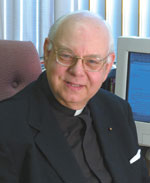The Most Holy Body and Blood of Christ, Corpus Christi / Msgr. Owen F. Campion
The Sunday Readings
 Providing the first reading for Mass on this feast is the Book of Exodus, the story of an event that occurred as the Hebrews made their way across the Sinai Peninsula, in flight from Egypt and slavery.
Providing the first reading for Mass on this feast is the Book of Exodus, the story of an event that occurred as the Hebrews made their way across the Sinai Peninsula, in flight from Egypt and slavery.
To modern ears, the story may sound gruesome, giving the details as it does of the ritual sacrifice of a young bull, but then ritual slaying and sacrificing of animals were common then.
The ceremony required that the blood be sprinkled on the people. This gesture showed the thinking that life itself resided in a creature’s blood. It is not difficult to understand how this notion originally arose. The ancient peoples had a limited knowledge of physiology, but they knew if the blood stopped flowing, the creature died; if enough blood escaped from the body due to hemorrhage, then death followed.
Offering the bull to acknowledge God’s majesty made the bull holy. Its blood therefore was holy, and because of the sacrifice, the blood somehow was touched by God’s own life. By sprinkling this blood on the people, they in turn were touched by God in a special way.
For ancient Jews, these sacrifices had a message, the core of which remains good today to consider, despite our culture’s different views on this kind of sacrifice.
The Epistle to the Hebrews is one of the New Testament’s most eloquent sources for knowledge about the person and mission of the Lord. This feast’s selection is wise. From the reading, we learn about the miracle of the Mass.
This reading stresses that Jesus is the perfect victim of sacrifice as well as the great high priest. The sacrifice of bulls is no longer necessary. Jesus replaced that ritual by giving us the Holy Sacrifice of the Mass, and therefore the Blessed Sacrament.
The Mass is the sublime offering of the innocent Lamb of God, Jesus the Lord.
The three synoptic Gospels report the Last Supper and the institution of the Eucharist by giving the actual words used by Jesus, “This is my body” (Mk 14:22), “This is my blood” (Mk 14:24).
This feast day’s reading is from St. Mark’s Gospel. Before mentioning the Last Supper, the Gospel says that Jesus sent two disciples into the city. He told them that they would see a man carrying a water jar. They should follow this man. The man will go to a house, Jesus said, whose owner the disciples should encounter and ask for a room in which the Lord and the disciples could gather to eat the Passover meal.
An interesting passage, it reveals that the Last Supper, and all that happened at the Last Supper, were utterly within the plan of God. It was no ordinary meal. God prepared it to provide the means of human beings to unite with Jesus.
Reflection
Cathedrals often place tabernacles in special chapels, not to diminish the Eucharist, but instead to give the Blessed Sacrament greater prominence and to provide worshippers opportunities to pray before the tabernacle without distraction and more intimately.
St. Matthew’s Cathedral in Washington, D.C., is one of the glories of American Catholic architecture. Its mosaics are breathtakingly beautiful. The wall behind the tabernacle in its Blessed Sacrament chapel, in mosaic, displays images of the two disciples who walked with Jesus to Emmaus, as told in St. Luke’s Gospel. An inscription reads, “They recognized him in the breaking of the bread,” an ancient Christian term for the Eucharist.
This great feast celebrates that Jesus, the Son of God, the Savior of the world, literally is present in the Blessed Sacrament.
Those who pray before tabernacles, in churches great or small, have found the Lord in the “breaking of the bread,” and they wish to be near Jesus and with Jesus. He is everything. †
 Providing the first reading for Mass on this feast is the Book of Exodus, the story of an event that occurred as the Hebrews made their way across the Sinai Peninsula, in flight from Egypt and slavery.
Providing the first reading for Mass on this feast is the Book of Exodus, the story of an event that occurred as the Hebrews made their way across the Sinai Peninsula, in flight from Egypt and slavery.